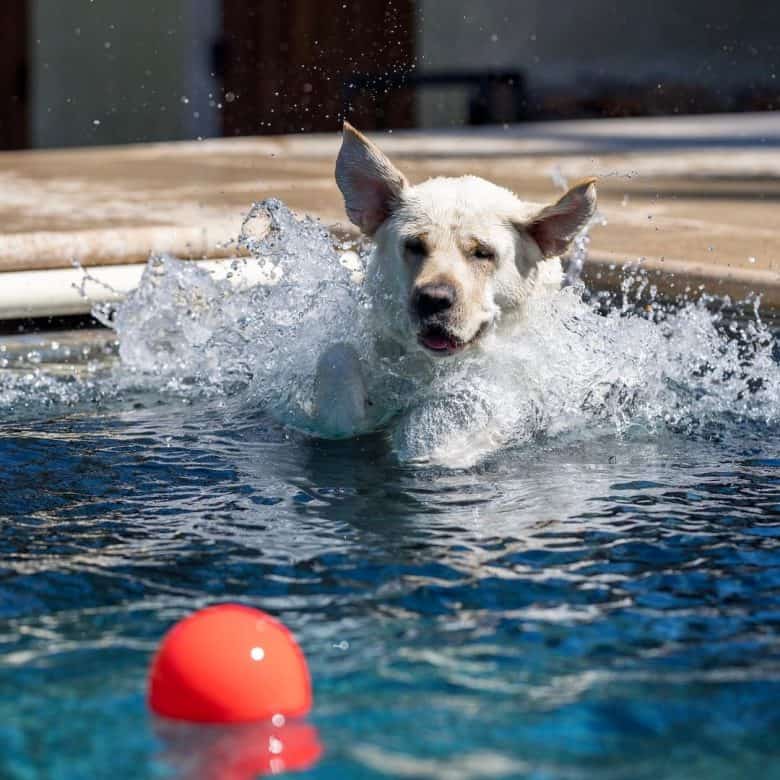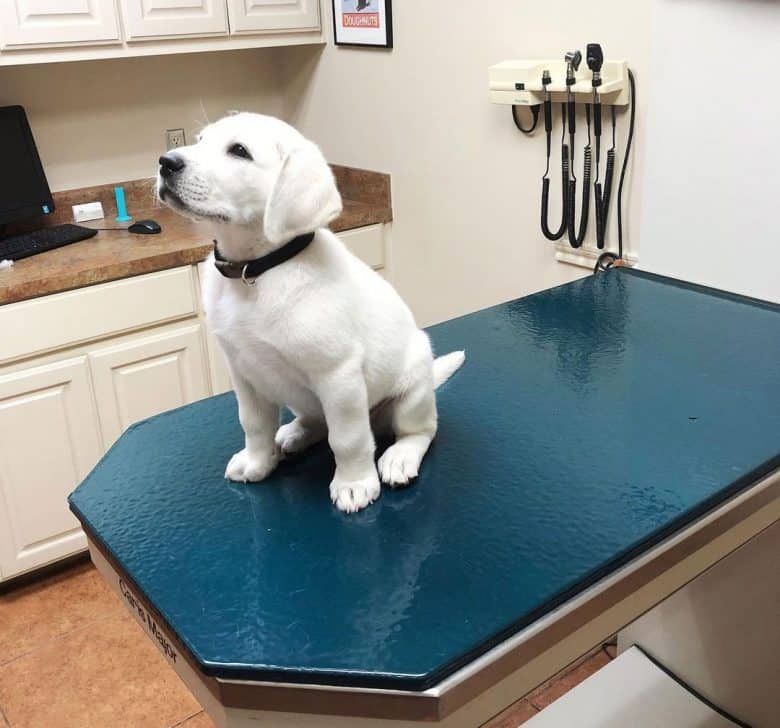In fact, all Labradors are descended from the St. John’s water dog, also known as the lesser Newfoundland dog. These dogs were originally black and primarily used by fishermen in the early days.
Soon, these talented and hardworking dogs became one of the most popular breeds for hunting and retrieving purposes. Until the late 1990s, it wasn’t until light-colored Labrador retrievers were considered desirable in any way.
Prior to that, Yellow Labrador puppies, along with their Chocolate littermates, were frequently put down at birth. A good reason for the change in color trend was due to the success of a television commercial featuring a light-colored Labrador.
Currently, Labrador retrievers are the most popular breed of dog in the United States. Apparently, according to the US Today, they broke the record for “longest tenure as top dog” in 2013!
Labradors are incredibly popular along with the fact that you can find them in a wide variety of colors. Among chocolate dogs, there are dogs that range from a light brown to a deep mocha, and yellow labs can be snow-white or fox red in color.
White Labs are either light yellow labs with the albino gene or very light yellow labs with the white gene. Puppies with the albino gene cannot be registered with the AKC.
Yellow Labs, on the other hand, can be registered with kennel clubs under the Yellow Lab category, whereas white Labs, on the other hand, cannot.
What does a White Lab look like?
Like any other coat color, white Labradors are athletic dogs with a muscular build and a smooth coat. Their form should be ideal for retrieving purposes according to the American Kennel Club breed standard.
Their strong otter tail is also another characteristic that makes them stand out. It is important to keep in mind that they have very minimal feathering, unlike the Golden Retriever which is heavily feathered.
They should have a dark brown color to their eyes and a black nose when it comes to their appearance. There are some breeders who prefer black labrador retriever dogs with solid coats, but Black Labrador Retrievers with a small white spot on the chest are allowed.
Any dog that is misshapen or has an excessively slender or short body is disqualified from the show ring.
White Labradors come in a variety of types
At its most basic level, white Labradors are Labradors that have a coat that is white, or close to white, in color. In spite of this, their coat takes on this unusual pigment for a Labrador for a number of different reasons.
Yellow Labradors
In most cases, White Labrador dogs are Yellow Labradors that are extremely pale in color. As with all other Labs, these dogs are exactly the same; it’s just that both of their parents carried the genes that allowed them to develop a coat that resembles a white one.
In addition to having the same black or brown nose and eyes as other labs, they will also be intelligent and have the same temperament as well. Additionally, they will also face the same health risks, but will not be exposed to any additional ones due to the color of their coats.
There are a variety of colors available for yellow labradors, from fox red, to yellow and golden, as well as cream and, of course, white. Obviously, white is just one of many colors that can occur naturally in the yellow labrador breed.
The White Labrador breed is usually created by breeders who have been focusing on extending the color range of Yellow Labradors for decades in order to meet the growing market demand for these dogs.
As a consequence of the history of the breeding, white Labradors are more likely to be English Labradors than American Labradors. The result will be that they will also have the stockier, broader look that the English Lab currently has.
Albino Labradors
Unlike Yellow Labradors with white coats, which are healthy dogs that are not different from their darker colored siblings and sisters, some White Labradors appear to be the result of albinism. There is a genetic condition that is universal throughout the animal kingdom, except that it is rare in dogs, as it affects maybe one in every 20,000 dogs.
A person who is albinized has a gene that turns off the pigments in his or her skin, causing the animal to appear white. The result of this is that the dog has white hair and its skin appears to be extremely pale in color.
Yellow Labs that are white are usually easily distinguished from Yellow Labs that are white as they usually lack pigment in their eyes and noses as well. They are often distinguished by a distinctive red color for their eyes, though they can also be blue in color.
Due to their lack of pigmentation, albino Labradors are more likely to suffer from health problems than their pigmented counterparts. The skin of these animals is particularly vulnerable to sun damage, which can easily result in tumors and skin cancer as a result.
Furthermore, their eyes are also very sensitive to the sun’s rays and can easily become damaged by them. It is also common for them to be blind or suffer from eye deformities due to the sun’s rays.
Leucistic White Labrador
Leucistic White Labradors are different from both white-colored Yellow Labradors and albino Labradors because they have yellow eyes. The leucistic condition differs from albinos because it means “low pigmentation” and rather than being unable to produce pigment, the cells that would produce the pigment are prevented from migrating to the area where it is needed.
Similar in appearance to vitiligo in humans, this can be a generalized condition that affects the entire dog’s skin, or just specific areas. There is a possibility that these puppies will have normal eye color, which can make it hard to distinguish them from albino puppies.
It is also a condition that is relatively rare among Labradors, due to the recessive nature of the condition.
As the areas of the skin that lack pigment are also easily damaged by the sun, it can bring about similar health concerns for the individual. It is important to note that they are not at the same risk as far as the eyes are concerned.
Silver Labrador
In addition to white labradors, Silver labradors should also not be confused with white labradors, which are caused by the dilution of the darker pigment in black and brown dogs.
As opposed to White Labradors, which are not only accepted in shows but also prized, Silver Labradors cause quite a bit of controversy, with many claiming they are a “disaster” for the breed.
It is possible to register them with the Kennel Club as Chocolate Labradors, but they are not allowed to participate in shows.
Nevertheless, just as in the case of Yellow Labradors, these silver coated Chocolate Labradors are natural within the range of colors which are associated with Labradors and they do not show any additional personality traits or health issues because of the color of their coat.
Adopting A White Labrador
As mentioned earlier, there are only three official colors of Labrador Retrievers – Black, Chocolate, and Yellow – with Black being the most common, while Chocolate and Yellow are about half as common as Black.
As a result of this, as well as the fact that White Labradors are relatively rare among Yellow Labradors, it is not always easy to find White Labradors.
If you want to find a white Labrador, you will need to contact a breeder who has selected color to be one of the traits they are controlling in their breeding program.
Despite this, it is not advisable to work with a breeder who only or primarily controls for color, as health and temperament are at the same time more important characteristics in a dog than color.
There is a greater population of White Labradors among English Labs than American Labs, so it may be worthwhile to speak with a breeder of English Labs.
It is important to keep in mind that English Labradors look different; they tend to be stockier and rounder in the chest area and face.
Additionally, they have different personalities as well. On one hand, they tend to be more playful and silly, but on the other hand, they have less energy. As a result, they have become very popular dogs on the show circuit, while their friendly and funny personality makes them great family pets.
In some cases, it can be difficult to know if a Lab puppy will grow up to become a true white Lab when they are a pup, as many Yellow Labradors are born with a very pale coat that gets darker with age.
With prolonged sun exposure, parts of a White Labrador’s coat, especially the tips of the ears, can also turn yellow.
The cost of an average Labrador can range anywhere between $300 and $3,000 depending on where you are located and what breeder you choose.
The price of a White Lab in a litter should not be higher than the price of any other lab in the litter, but of course, this depends on the breeder’s discretion.
In spite of the fact that seeking out a white Yellow Labrador might be something you desire, seeking out an Albino Lab or even a Leucistic Lab might not be the best choice because of the health issues associated with these pets. But that is not to say that there aren’t any Albino Labs out there who are looking for a loving home and who need to be adopted by someone.
American Or English Labrador?
The fact that finding a White Labrador will probably mean choosing between an American and an English Labrador, it is worth considering the differences between the two breeds.
It should be noted that both of these dogs are friendly, good-natured, and companionable, as well as intelligent and easily trained. That is why they make wonderful companions, as well as excellent working dogs. However, both of these dogs were originally bred as retrievers.
The American Labrador is a type of dog that has been bred for working while the English Labrador has been bred for conformation, which means they have been bred in a way that more closely aligns with the definition of the species, so they are excellent choices for a show dog.
They are called English Labradors because they are considerably more common in the UK than elsewhere in the world. In the meantime, if you haven’t already guessed, the working-style Labrador tends to be more popular in the United States.
This is merely a description of how the breeds are characterized, but it is far from definitive as you will often see English Labs being used as working dogs and American Labs competing in dog shows.
As such, these are not precise definitions; rather, they are a useful guide to assist you in distinguishing between the two extremes of the breed. Licensed by the Kennel Club, each of the dogs is a registered Labrador Retriever.
Having said that, there are a few key differences that you should be aware of.
American Labradors are typically a bit taller, ranging from 21.5 to 24.5 inches, while English Labradors mostly start out at 21.5 inches, but they seldom reach a height of more than 22.5 inches.
Because American Labs tend to have longer legs, while English Labs are typically stockier, there is a height difference between the two breeds. However, American Labrador puppies are also heavier than their English brothers and sisters, ranging from 70 to 100 pounds, whereas English Labs are usually between 60 and 85 pounds.
The appearance of the two dogs is also very different from one another. The English Lab looks heavier and more substantial, with a barrel chest, unlike the American Lab. Also, they have a wider head and a fuller face with a shorter muzzle, in addition to having a bigger head. They have a thicker neck, and their coat is also thicker (so they also shed a bit more as a result).
There is no doubt that American Labs tend to have more energy than English Labs, and as a result, it is often thought that a firmer hand is needed to keep American Labs under control. They are often considered better as working dogs for this reason, and when they move into the home, they need a very active family to make sure they are happy there.
As English Labradors are considered to be calmer and quieter than American Labrador retrievers, they are more versatile as a family dog and are also easier to train for shows. The dogs do, however, exhibit enough drive to make excellent working dogs and are an excellent choice for tasks such as guide dogs, since they are committed, but will not tire their owner out.
American White Labs vs English White Labs
Labradors, like many other working breeds of dogs, fall into two broad categories. It is generally accepted that show dogs are called English Labradors, whereas field dogs are known as American Labradors. For more information, you can check out this article.
White English Labradors, which are favored in show rings because they are also white, are largely English Labradors. A Labrador Retriever is stockier than a Labrador Retriever, which rarely has the characteristic blocky head.
The fact that there are American White Labs does not imply there aren’t any. American White Labs tend to be bigger and more active than standard Labs. Whether a working dog or a companion dog, both make excellent companions, but both require a firm and experienced hand.
White Lab vs. Dudley Lab
It is important to note that white Labradors are different from another type of yellow Labrador known as the Dudley Labrador. The main coat color of a White Lab is white, while the main coat color of a Dudley can be more yellow or tan in color.
Among the most noticeable differences between white Labs and Dudley Labs is the pigmentation around the eyes, mouth, pads of the paws, and the nose.
It is common to see dark brown or black areas on a white Lab, as with a typical Lab of any other color.
However, on a Dudley lab, those areas have little to no pigmentation, which is why they appear pink when viewed under the microscope.
How big do White Labs get?
It is known that Labradors are a medium-large breed, and you can expect your dog to grow up to 22.5 to 24.5 inches (57 to 62 cm), however females stop growing at 21.5 to 23.5 inches (54 to 60 cm).
Females can weigh anywhere between 55 lbs and 70 lbs (25 to 32 kg) and males can weigh anywhere from 65 to 80 lbs (27 to 36 kg).
There should be no difference in size between the Labs of different colors. In case you are concerned about your Lab’s size or want to learn more about the Lab’s growth, we have a Lab Growth Chart available for you to view.
Do White Labs turn yellow?
A puppy may sometimes become darker or lighter as he or she loses the protective coat that he or she had as a puppy. Your Lab’s guard hairs, which is the top layer of his double coat, are responsible for this change.
Their undercoat is usually lighter in color and much softer than their outer-coat, which is usually wiry and tough.
Keep an eye on the development of Banjo the White Labrador as he grows up, and keep an eye out for how different his adult coat looks as a puppy and as an adult:
The change wouldn’t be drastic, but you might find your White Lab turning a light cream. You might also notice that its ears are darker than the rest of its body.
The same applies to any other color of Labrador, even the Fox Red Lab or Silver Labrador.
They are also known as Yellow Labs, but they have a genome that dilutes the coat color so that it appears ghostly, just like a Weimaraner dog has a ghostly cast.
Are White Labs good pets?
In my opinion, black labs make better hunters than any other breed. Chocolates are for show rings, not hunts. Guide dogs with yellow markings are chocolates. These are all stereotypes and none of them are true.
No evidence has been found that suggests the color of the Lab coat has any effect on the behavior or temperament of the dog.
To put it simply, we believe that White Labradors can be great pets, great hunters, and can also be excellent show dogs. Obviously, this popular breed of dog is loved for a reason. There are a variety of breeds of cats that are specifically bred for their affable nature and willingness to please.
When properly trained, Labrador Retrievers are a joy to be around, especially when they love the company of their families.
How to take care of your White Labrador
Except for the fact that dirt tends to show up much more easily on white dogs than on dogs with darker colored fur, White Labs aren’t more high maintenance than any other dog.
You will need to brush them vigorously once a week and trim their nails when they become too long if they get too long. You will not need to bathe them frequently. On the contrary, you should try to stretch as long as possible between baths.
If need be, use wet wipes or rinse them off with a garden hose if need be. The use of doggie shampoo should be reserved for those special occasions when you are really, really filthy.
Exercising your white lab.
The Labrador is a breed of dog that is very active. We are talking about an hour’s worth of exercise every day, and we are not talking about a simple stroll along the street. It must be engaging and they must be able to really work up a sweat.
Having too much pent up energy can cause a Lab to become destructive without the proper stimulation.
Swimming, hiking, cycling, and hunting are a few of the activities you can try. They will also enjoy activities such as hide and seek with the kids or playing fetch in the dog park with the dogs.
You should not, however, expect that after you get your new puppy that you’ll be able to pick him up and exercise him for an hour straight.
In fact, you should exercise them based on their age rather than the other way around. For a puppy who is just three months old, that is only 15 minutes a day.
What is the best grooming brush for a White Labrador Retriever?
In spite of the fact that labs have short fur, their double coats blow out twice a year, which is very unusual. If this happens, everything will be covered in a layer of fluffy stuff.
It is most definitely true that these products are not hypoallergenic and they will need to be treated accordingly once this happens.
In order to remove dead fur from the undercoat, you can either use a deshedding tool or a slicker brush, which does the same thing essentially without the need for blades.
There are some dog owners who avoid purchasing Furminators since excessive brushing can cause damage to their dog’s coat.
Please do not ever shave your dog unless it is suggested by your veterinarian. In the same way that we wear clothes for protection, our dogs’ coats are as essential to them as ours. It keeps them warm in the winter and believe it or not, it also keeps them cool in the summer.
How much should I feed my White Labrador?
Regardless of whether a dog is a white labrador or a black labrador, they need high-quality kibble made of high protein, low fat, and moderate carbs.
It is important to feed them according to their age. An active adult Labrador that weighs 70 lbs (31 kg) should be eating 3 ½ cups a day.
There is a special kibble designed for large breed puppies which should be fed to white Lab puppies.
By doing so, we are ensuring that their bones stay healthy and strong, which will increase the chances of their preventing hip dysplasia and other joint disorders.
You can check out our article on the best dog food for Labradors if you’re a first-time dog owner, or if you simply want some suggestions on what food to give your dog.
White Labrador health issues
The general consensus is that Labradors are healthy dogs. As with many large breeds, they suffer from obesity and hip dysplasia, which are problems associated with most large breeds.
One of the things that Labradors are prone to are muscular skeletal disorders and cancer, which affect them significantly more than other breeds.
Also, you should keep an eye out for ear infections and problems with the eyes. They may be at risk of developing progressive retinal atrophy, also known as PRA.
It is a condition that will cause blindness and there is no cure or treatment available for this condition. The good news is that breeders are able to exclude affected dogs from breeding by means of a health screening procedure.
Is there anything sinister about the white coat of a Labrador puppy? They might look fascinating, but are they harboring some dark secrets? There is a possibility, however, that some white dogs may have certain health problems due to albinism.
It’s important to note, however, that the Labradors that are unaffected by this genetic mutation will be as healthy as any other Labrador.
White Lab vs Albinism
There are many factors that contribute to a dog’s appearance, and it can be largely attributed to its genetic makeup. The two kinds of melanin produced in dogs are eumelanin and pheomelanin, and these two produce either black or brown coats.
There is a color diluting gene in Silver Labs that suppresses the color of their coat, while albino Labs lack the gene responsible for expressing their coat color. The albinism that occurs in dogs is rare, and there are different levels of this albinism.
It is possible for partial albinos to have some very light pigmentations in some parts of their bodies, especially near their stomach. The skin of albinos, including the eye rims and noses, is likely to be pink in color. They will also likely have blue eyes.
It is almost unheard of for dogs to have pink eyes.
In addition, dogs with the albino trait can suffer from light sensitivity and therefore will need special coverings if they are going to be outdoors in the afternoon sun.
There are more chances for them to suffer from blindness, deafness, skin cancer, as well as genetic deformities as a result. As a result, it will require you to spend more time and effort in caring for them. Albino Labrador puppies are also rather short-lived.
Fortunately, White Labs do not experience this problem and will be able to live the expected 10 – 12 years.
Besides the standard White Labrador, there is also a type called the leucistic White Labrador. Doggos with very little pigment could easily be mistaken for albinos as they have very little pigment.
The main difference is that Labradors that are affected by this gene will have brown eyes instead of blue ones. Furthermore, some dogs may look piebald, while others may be completely white.
In order for leucism to manifest, both parents must carry the recessive gene, which means both parents have to be carriers in order to cause it. Some of the partially leucistic labs may have random patches that have all of their colors bleached out.
How much do white lab puppies cost?
Due to the limited number of white Lab puppies compared to other colors of Labs, you may have to pay a slightly higher price when buying a white Lab puppy.
In the United States, a white Labrador puppy is likely to cost you between $1000-$2000, depending on your location and the breeder you choose. In addition, you may also need to travel to find a white Labrador breeder, since white Labradors are less frequently bred and may be a little more difficult to find.
It is important, however, to remember that there are many other costs associated with white Labs in addition to the initial puppy costs. I would suggest looking at the Cost of Owning a Labrador if you are considering adding a Labrador to your family to ensure you know what you are committing to.
Alternatively, you may also be able to find a white Labrador through a rescue organization and perhaps you can adopt an adult or senior white Labrador who needs a loving home.
There is no doubt that you will have to choose your breeder carefully if you are determined to get a white Lab puppy. We will discuss some tips that will help you locate an ethical and reputable breeder later in this article due to the fact that choosing the right breeder can have a significant impact on the health and success of your dog.
Adopting a White Labrador
When you adopt an adult dog, one good thing about it is that what you see is what you get. On top of that, they are much cheaper than puppies.
It is not common to find white Labradors at a shelter. It is not hard to understand why they are a popular option because they are appealing and who can resist them? If you have your heart set on adopting, here are a couple of shelters that you might want to consider:
- The Heart of Texas Lab Rescue (Austin, Texas)
- The Texas Sporting Breed Rescue (Denton, Texas)
- The Lucky Lab Rescue (Texas, Minnesota, Nebraska)
Who should get a White Lab dog?
Those looking for a best friend that will also get along with any additional family pets they may have should definitely consider a Labrador. Although they aren’t the best guard dogs, they’ve been known to bark at the occasional stranger in the past.
Since White Lab pups have a small chance of turning darker, if you’re dead set on owning a White Lab, you should adopt rather than buy in order to mitigate the risk of it turning darker.
Health & Lifespan of White Labs
A white Labrador Retriever is a subset of a yellow Labrador Retriever, and it has a similar life expectancy of approximately 10-14 years with the yellow Labrador Retriever. It has been found that only chocolate Labs, out of all Labrador colors and sub-colors, have a shorter life expectancy of 10.7 years.
You have a lot of factors to consider when it comes to how long your Lab will live, including their breed and inherited health history, access to quality veterinary care, as well as good food, nutrition, and exercise.
As is the case with any breed, including white Labrador Retrievers, there are several health conditions that are present in all colors of Labradors. Among these conditions are:
- Joint Issues/Dysplasia
- Allergies
- Thyroid Issues
- Exercise-Induced Collapse
- Retinal Myopathy
- Cancer
Because white Labrador retrievers are less common than other yellow Labrador retrievers, you will need to take extra precautions in order to ensure your puppy is healthy. There is no guarantee that your dog will live a long and healthy life, but you will want to make sure that you don’t run into health problems caused by inbreeding.
It is very important that if you are buying a puppy, you discuss the health history of the parent dogs with the breeder you select, and that any possible health issues have been tested for. We will go over this in more detail in the section below that discusses breeders.
English Cream Labradors
Some breeders specialize in breeding white Labradors that are referred to as English Cream Labradors.
I consider this type of white Lab to be a very creamy, stocky, English Labrador, which is a little shorter in legs, has a thicker tail, and a blockier head shape than the American type of Labrador Retriever.
The coat color of its overall coat may be slightly yellow with a hint of white rather than being a pure white, as is the case with other white Labradors.
American white Labradors will have lengthier legs than their English Cream counterparts, as well as a leaner overall body shape and a slightly larger size. If you would like to know more about the differences between English Labradors and American Labradors, please review our FAQ section on the Labrador breed.
Although it is possible to find white Labradors that are not English Cream Labs, you should be aware that some breeders will specialize in producing English Cream Labs as their type of white Labrador.
How to Find a White Labrador Breeder
Before you make a decision to buy a white Labrador puppy, it is essential that you research breeders thoroughly and carefully before you make that decision.
In spite of the fact that Lab puppies are extremely adorable and very hard to resist, you’ll want to make your decision very carefully and with a lot of patience and care.
Your dog’s health and your ability to build a successful relationship with your dog will both be greatly influenced by the breeder you choose. You should also look for a breeder who tests for health issues in the parent dogs before breeding them, and has certifications from a vet to demonstrate that they have done this.
Because white Labradors are less common and thus harder to find, you are likely to have fewer choices for the breeders you can choose from, and you may even have to travel for one once you have identified one and decided which one is right for you.
The Labrador Retriever Club’s Breeders Directory is a good place to begin looking at what options may be available to you as you begin your search for the right breeder.
If you have already started your search there, we have some suggestions for how to further extend and refine your search to find the perfect breeder for your next pet.
White Lab Breeders
Although it is fairly easy to find a Labrador breeder on Yahoo or through the AKC’s marketplace, you should be extremely careful when selecting a White Labrador breeder.
Sadly, there are unscrupulous ones who don’t bother with health screenings or socialization. Unfortunately, dogs that come from unfavorable backgrounds are often afflicted with behavioral problems as well as medical problems.
Additionally, breeders who are only interested in breeding dogs of a particular color often do so for the purpose of making a profit.
There is a general rule of thumb when it comes to selecting a breeder: if you aren’t happy with the breeder, you won’t be happy with the puppy either, so pick wisely!
Here are a few that we have come across:
- The Snowy Pines White Labrador Retrievers (Ozark, MO)
- White English Puppies At Royal Labradors and Terriers (Mora, MN)
- Idle Wild Labradors, Shelbyville, Tennessee (Shelbyville, TN)
Final Thoughts
When breeders refer to a White Labrador, they are referring to a Yellow Labrador that has been specifically bred to have very pale fur. This is opposed to a White Labrador. They are more common in English Labs than in American Labs, but they are a naturally occurring phenomenon that arises from breeding.
All of these dogs have all the wonderful characteristics that Labradors are known for. They make excellent family dogs, working dogs, and show dogs due to their friendly and intelligent disposition.
It should be noted, however, that these White Labs should not be confused with the Albino Labs or Leucistic Labs, which are dogs with rare genetic conditions that mean they lack pigment in their skin. In fact, dogs that are exposed to the sun can suffer from serious health problems as a consequence. In spite of the fact that there are dogs of this variety out there in need of a loving home, the situation is different than adopting a White Labrador. They do require special care and attention on a regular basis.
OUR EXPERIENCE: While Archer was a little different compared to other Labrador Retriever puppies we have had, he still had a lot of the same characteristics and personality that I find in most Labs. He was trained for over twelve years and began working as a service dog for a four year old girl with a traumatic brain injury after he was trained for over twelve years. When Archer met his new companion for the first time, it was also the first time the little girl ever spoke to him. This was incredible!
Yes, White Labradors are very rare breeds. The incidence of albinism in dogs is extremely rare, maybe one in every 20,000 dogs has albinism. It is also rare to find White Labradors that look like pale Yellow Labradors. It is important to note that White Labs are the very extremes of the range of colors available for these pooches, and it is imperative that both parents have the genes that allow for this extremely light color.
The amount of size your Labrador gets depends on a lot of things, but the color is not one of them. If you look at the size of your Labrador’s parents, then you will be able to make an informed decision regarding their future size.
According to general regulations, you can expect your White Labrador to weigh between 70 to 100 pounds if he or she is an American Labrador. Although English Labradors appear to be stockier than their American counterparts, they are typically lighter, weighing between 60 and 85 pounds. They are also usually smaller than American Labradors.
As with most Labrador Retrievers, the White Labrador has a life expectancy of around 12 years, so about the same as the majority of Labrador Retrievers. White Labradors that are albino will have significantly shorter life expectancy than those who are not albino, since they are much more likely to develop serious medical conditions, such as skin cancer and tumors.
White Labradors are purebred dogs that fall into the Yellow Labrador Retriever category, and they can therefore be registered for shows and with the Kennel Club as Yellow Labrador Retrievers.
Yes, that’s correct. Labradors are known to shed a lot, and they tend to shed a lot. The reason for this is the fact that they have a double coat, which means that they have a great deal of hair left behind. There can be a lot of challenges involved during the shed season, which is usually in the spring and fall. Hence, you will be finding those beautiful white hairs all over your home at the end of this process.
OUR EXPERIENCE: Okay, so our white Lab, Archer, shed like a crazy dog. It is safe to say that he sheds more than any other dog, whether it is a Labrador or otherwise, that we have ever owned.
The hair of a White Labrador, particularly around the tips of the ears, can turn yellow if it is exposed to the sun for an extended period of time. Additionally, it is common for some Yellow Labradors to appear white at birth, however, over the course of the first few months of their lives, their hair will darken. During the first few months of a Labrador’s life, it is impossible to know for sure whether he will be white or not.
















